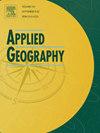How can ecosystem services trade-offs/synergies help select the optimal cultivated land restoration pattern? A study based on multi-scenario simulations
IF 4
2区 地球科学
Q1 GEOGRAPHY
引用次数: 0
Abstract
Nowadays, the growing "non-grain" use of cultivated land in certain regions of China has posed significant risks to local grain supplies. This has necessitated urgent restoration of "non-grain" cultivated land to its original purpose. Land use changes may have positive or negative effects on ecosystem services. This study explores whether and how cultivated land restoration can enhance grain production while minimizing regulating services loss. The Sanjianghui area in Hangzhou city, China, was selected as a case study to examine effects of different restoration scenarios, on provisioning and regulating services and their trade-offs. The findings suggested that the types, quantity and location of restored areas significantly influenced ecosystem services. Across eight scenarios, both trade-offs and synergies between provisioning and regulating services were observed as the restoration area expanded. The optimal scenario based on trade-offs and synergies was scenario 2035-Ⅱ, which recorded the highest synergistic intensity at 26.6%. Under this scenario, grain production increased by 5.32%, and regulating services improved by 0.11% compared to the 2020 baseline. This study presents a framework to simulate the most effective pattern of cultivated land restoration, enabling increased grain production without compromising regulating services. This research offers actionable guidance for cultivated land restoration and ecosystem management.

生态系统服务权衡/协同效应如何帮助选择最佳耕地恢复模式?基于多场景模拟的研究
如今,中国某些地区耕地“非粮食”利用的增长给当地粮食供应带来了重大风险。这就迫切需要将“非粮食”耕地恢复到原来的用途。土地利用变化可能对生态系统服务产生积极或消极的影响。本研究探讨耕地恢复是否以及如何在减少调节服务损失的同时促进粮食生产。中国杭州三江汇地区被选为案例研究,以检验不同恢复方案在提供和调节服务及其权衡方面的影响。结果表明,恢复区域的类型、数量和位置对生态系统服务功能有显著影响。在八个场景中,随着恢复区域的扩大,可以观察到供应和调节服务之间的权衡和协同作用。基于权衡和协同效应的最佳情景是情景2035-Ⅱ,其协同强度最高,为26.6%。在此情景下,与2020年基线相比,粮食产量增长了5.32%,调节服务改善了0.11%。本研究提出了一个框架来模拟最有效的耕地恢复模式,在不影响调节服务的情况下增加粮食产量。本研究为耕地恢复和生态系统管理提供了可操作的指导。
本文章由计算机程序翻译,如有差异,请以英文原文为准。
求助全文
约1分钟内获得全文
求助全文
来源期刊

Applied Geography
GEOGRAPHY-
CiteScore
8.00
自引率
2.00%
发文量
134
期刊介绍:
Applied Geography is a journal devoted to the publication of research which utilizes geographic approaches (human, physical, nature-society and GIScience) to resolve human problems that have a spatial dimension. These problems may be related to the assessment, management and allocation of the world physical and/or human resources. The underlying rationale of the journal is that only through a clear understanding of the relevant societal, physical, and coupled natural-humans systems can we resolve such problems. Papers are invited on any theme involving the application of geographical theory and methodology in the resolution of human problems.
 求助内容:
求助内容: 应助结果提醒方式:
应助结果提醒方式:


